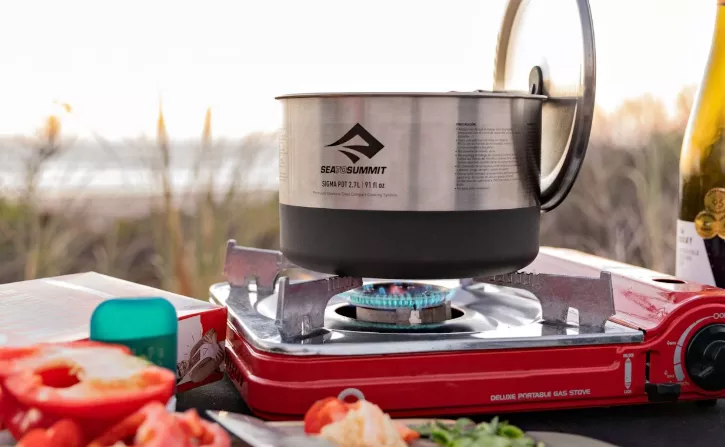Choosing the right gas type for your camping stove is important. It affects how easily you cook, how much gear you carry, and how well your stove works in different weather conditions.
1. Butane
What is Butane?
Butane is a common fuel for small and lightweight camping stoves. It is stored in canisters and is easy to use with portable stoves.
Benefits of Butane
- Lightweight and compact
- Easy to use and clean
- Burns clean with little odor
Drawbacks of Butane
- Performs poorly in cold temperatures
- Less available in remote areas
Best Use
Butane is best for fun camping in mild weather where weight and space matter.
2. Propane
What is Propane?
Propane is a gas that works well in both warm and cold environments. It is stored in heavier metal canisters or tanks.
Benefits of Propane
- Works in very cold temperatures
- Burns hot and steady
- Available in many camping stores
Drawbacks of Propane
- Heavier than butane
- Canisters take more space
Best Use
Propane is perfect for car camping or base camps where weight isn’t an issue.
3. Isobutane
What is Isobutane?
Isobutane is a more refined version of butane. It is often mixed with propane to improve performance in colder temperatures.
Benefits of Isobutane
- Performs better in the cold than regular butane
- Compact and light
- Used with many modern canister stoves
Drawbacks of Isobutane
- Still limited in extreme cold
- May be more expensive
Best Use
Great for backpackers and lightweight travelers who might encounter cool nights.
4. White Gas
What is White Gas?
White gas is a liquid fuel also called Coleman fuel. It is very pure and burns cleanly.
Benefits of White Gas
- Works in freezing temperatures
- Very powerful and efficient
- Reusable bottles reduce waste
Drawbacks of White Gas
- Requires priming before use
- More maintenance is needed
Best Use
Best for winter camping or high-altitude trekking where cold is a major concern.
5. Liquefied Petroleum Gas (LPG)
What is LPG?
LPG is a mix of propane and butane. It is widely used in larger stoves and grills.
Benefits of LPG
- Burns hot and clean
- Works in a range of temperatures
- Available in many sizes of tanks
Drawbacks of LPG
- Heavier than other options
- Not suitable for backpacking
Best Use
Ideal for family camping trips and long stays at one location.
6. Alcohol (Denatured Alcohol or Methylated Spirits)
What is Alcohol Fuel?
Alcohol is a liquid fuel used in simple stoves, like the ones made from cans or brass.
Benefits of Alcohol Fuel
- Very easy to find in most countries
- Stoves are ultra-light and simple
- Good for emergency use
Drawbacks of Alcohol Fuel
- Burns with a low flame
- Not very wind-resistant
Best Use
Great for ultralight backpackers and as a backup fuel option in your gear kit.
How to Choose the Right Gas Type
Consider Your Camping Style
Backpackers usually need lighter fuels like butane or isobutane. Car campers can go with propane or LPG. Winter hikers should look at white gas.
Check the Temperature
If camping in cold places, avoid pure butane. Choose propane, white gas, or LPG instead.
Think About Stove Compatibility
Make sure the gas canister or bottle works with your stove. Some stoves need specific fittings or adapters.
Tips for Safe Gas Use While Camping
- Always cook in well-ventilated areas
- Check for leaks before lighting the stove
- Store fuel away from direct sun and heat
- Use the correct canister for your stove model
Which Gas is Best for You?
Each gas type has its own strengths. The best choice depends on how and where you plan to camp. For example, this camping guide can help you match the fuel type with your camping needs.
| Gas Type | Best For | Cold Weather | Weight |
|---|---|---|---|
| Butane | Light camping, short trips | Poor | Light |
| Propane | Car camping, winter use | Excellent | Heavy |
| Isobutane | Backpacking, moderate cold | Good | Light |
| White Gas | Cold weather, high altitude | Excellent | Medium |
| LPG | Family camping, large stoves | Good | Heavy |
| Alcohol | Ultralight hiking, emergencies | Fair | Very Light |
Final Thoughts
The right fuel makes camping cooking easier and safer. If you’re planning your next adventure, think about where you’re going, how cold it will be, and how much you can carry. Whether you choose butane for a quick hike or propane for a big trip, knowing your options will help you enjoy a warm meal wherever you camp.
For more help planning your trip, explore this fun camping guide full of useful tips and ideas.
Related topics:
- No Fridge Camping: What Foods Can You Bring?
- How to Hang a Travel Hammock: The Ultimate Guide
- What Do You Do When Camping?

